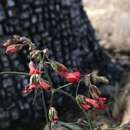Comments
provided by eFloras
Mirabilis coccinea is easily confused with M. linearis var. linearis when the flowers are closed. The distinction is more difficult when plants are cleistogamous (phase Allionia gracillima in M. coccinea; phases A. pinetorum and Oxybaphus bodinii in M. linearis). In general, leaves of M. coccinea are oriented at an angle of 45° or greater to the stem, the distal portion of the main axis of the inflorescence is glabrous to 2-3 cm from the flowers, and the peduncles are sparingly short pubescent. In var. linearis, the leaves are generally oriented at 45° or less to the stem, the inflorescence is densely pubescent, and the peduncles are densely spreading-pubescent. Reports of the occurrence of M. coccinea in Texas (e.g., D. S. Correll and M. C. Johnston 1970) are apparently based on literature records and perhaps on a labeling error of a probable isotype collected by Charles Wright. No specimens have been seen from Texas. P. C. Standley (1911) discussed the unique nature of the fruit and perianth of this species relative to sect. Mirabilis and sect. Oxybaphus; in the original description, Torrey noted the species to be intermediate between Oxybaphus and Quamoclidion.
- license
- cc-by-nc-sa-3.0
- copyright
- Missouri Botanical Garden, 4344 Shaw Boulevard, St. Louis, MO, 63110 USA
Description
provided by eFloras
Stems ascending to erect, 1.5-9 dm, glabrous basally, glabrous or rarely very sparsely puberulent distally. Leaves usually ascending or spreading at 45-90°, dark grayish green, moderately thick and fleshy; petiole 0-0.3 cm; blade linear to linear-lanceolate, 4.5-10 × 0.1-0.5 cm, base attenuate, apex acute, surfaces glabrous or rarely with few small hairs adaxially, glabrous abaxially. Inflorescences: peduncle 4-8 mm, spreading stiff short hairy or glandular-pubescent, crosswalls of hairs pale; involucres dark green, opaque, moderately veiny, 4-7 mm in flower, 4-8 mm in fruit, softly hirtellous or glandular-hirtellous, bracts 30-40% connate, lobes narrowly ovate or triangular. Flowers: perianth bright red-purple, 1.3-2 cm. Fruits pale olive brown, 4.5-6 mm; ribs round, 0.5-0.8 times width of sulci, 0.5 times as wide as high, smooth or slightly warty or with warts equaling height of ribs; sulci smooth.
- license
- cc-by-nc-sa-3.0
- copyright
- Missouri Botanical Garden, 4344 Shaw Boulevard, St. Louis, MO, 63110 USA
Distribution
provided by eFloras
Ariz., Calif., N.Mex.; Mexico (Sonora).
- license
- cc-by-nc-sa-3.0
- copyright
- Missouri Botanical Garden, 4344 Shaw Boulevard, St. Louis, MO, 63110 USA
Flowering/Fruiting
provided by eFloras
Flowering late spring-early fall.
- license
- cc-by-nc-sa-3.0
- copyright
- Missouri Botanical Garden, 4344 Shaw Boulevard, St. Louis, MO, 63110 USA
Habitat
provided by eFloras
Dry, open hillsides of igneous rock, shrubs, pinyon-juniper or mixed conifer woodlands; 1200-2000m.
- license
- cc-by-nc-sa-3.0
- copyright
- Missouri Botanical Garden, 4344 Shaw Boulevard, St. Louis, MO, 63110 USA
Synonym
provided by eFloras
Oxybaphus coccineus Torrey in W. H. Emory, Rep. U.S. Mex. Bound. 2(1): 169. 1859; Allionia coccinea (Torrey) Standley; A. gracillima Standley
- license
- cc-by-nc-sa-3.0
- copyright
- Missouri Botanical Garden, 4344 Shaw Boulevard, St. Louis, MO, 63110 USA
Comprehensive Description
provided by North American Flora
Allionia coccinea (Torr.) Standley, Contr. U. S. Nat. Herb
12: 339. 1909.
Oxybaphus coccineus Torr. Bot. Mex. Bound. Surv. 169. 1859.
Mirabilis coccinea Benth. & Hook. Gen. PL 3: 3. 1880.
Oxybaphus UnearifoUus S. Wats. Proc. Am. Acad. 17: 375. 1882.
Allionia linearifolia Kuntze, Rev. Gen. 533. 1891.
Mirabilis coccinea scabridata Heimerl, Ann. Cons. Jard. Geneve 5: 186. 1901.
Allionia linearis coccinea M. B. Jones, Contr. West. Bot. 10: 51. 1902.
Allionia gracillima Standley, Contr. U. S. Nat. Herb. 12: 340. 1909.
Allionia gracillima filifolia Standley, Contr. U. S. Nat. Herb. 12: 340. 1909.
Allionia gracillima scabridata Standley, Contr. U. S. Nat. Herb. 12: 340. 1909.
Allionia linearifolia filifolia Standley, Contr. U. S. Nat. Herb. 16: 120. 1913.
Stems solitary or numerous from an elongate woody root, erect or ascending, sparsely or copiously branched, the branches very slender, glaucous, glabrous, ascending, the internodes short or elongate; leaves numerous or few, sessile, the blades filiform or linear, 2-12 cm. long, 1-4 mm. wide, long-attenuate to each end, thick and succulent, glaucous or glaucescent, at least beneath, glabrous; involucres slender-pedunculate, axillary and solitary in young plants and mostly with cleistogamous flowers, in mature plants arranged in loose paniculate cymes, these with slender, opposite, sparsely short-pilose branches; involucres at anthesis 4-5 mm. long, short-pilose or puberulent, deeply lobed, the lobes oval-ovate, acute or acutish, slightly accrescent in a.ge; flowers 1-3 in each involucre, the perianth 15-20 mm. long, deep purplishred, the tube 3-4 mm. in diameter, gradually widening upward, the limb 11-15 mm. broad, deeply 5-lobed, the lobes retuse; stamens 5, exserted; anthocarp obovoid, 5 mm. long, olivaceous, finely hirtellous, 5-lobed, the angles broad, smooth or tuberculate, the sulci coarsely transverse-rugose; seed broadly obovoid, 2.5 mm. long, pale yellowish-brown.
Type locality: Hillsides, Copper Mines [Santa Rita], New Mexico.
Distribution: Dry hillsides, southwestern New Mexico, southeastern Arizona, and northern Sonora.
- bibliographic citation
- Paul Carpenter Standley. 1918. (CHENOPODIALES); ALLIONIACEAE. North American flora. vol 21(3). New York Botanical Garden, New York, NY
Mirabilis coccinea: Brief Summary
provided by wikipedia EN
Mirabilis coccinea, the scarlet four o'clock, is a spring wildflower native to the southwestern United States and northwestern Mexico. The plant grows to two feet with deep red flowers which open at night. The plant can be found on washes, plains, and rocky slopes.
- license
- cc-by-sa-3.0
- copyright
- Wikipedia authors and editors

